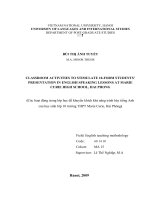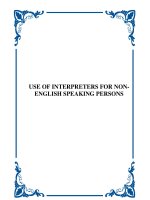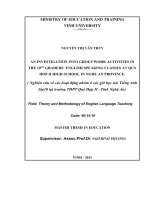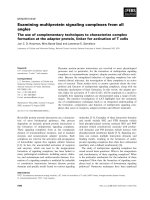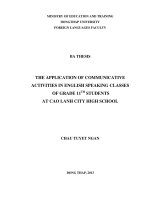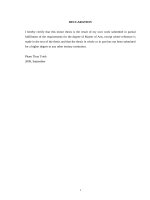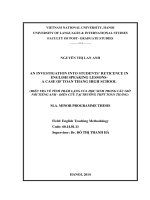Teachers' use of eliciting techniques in English speaking lessons at Son Tay Upper Secondary school, Hanoi
Bạn đang xem bản rút gọn của tài liệu. Xem và tải ngay bản đầy đủ của tài liệu tại đây (1.77 MB, 66 trang )
VIETNAM NATIONAL UNIVERSITY, HANOI
UNIVERSITY OF LANGUAGES AND INTERNATIONAL STUDIES
FACULTY OF POST- GRADUATE STUDIES
CAO THI
̣
HÔ
̀
NG PHƢƠNG
TEACHERS’ USE OF ELICITING TECHNIQUES IN ENGLISH
SPEAKING LESSONS AT SON TAY UPPER SECONDARY SCHOOL,
HANOI
(Sử dụng thu
̉
thuâ
̣
t gơ
̣
i mơ
̉
trong giơ
̀
da
̣
y no
́
i Tiê
́
ng Anh cu
̉
a gia
́
o viên THPT
Sơn Tây, H Ni)
M.A MINOR THESIS
FIELD: ENGLISH TEACHING METHODOLOGY
Code: 60 14 10
Cohort: MA 18
HANOI , 2011
VIETNAM NATIONAL UNIVERSITY, HANOI
UNIVERSITY OF LANGUAGES AND INTERNATIONAL STUDIES
FACULTY OF POST- GRADUATE STUDIES
CAO THI
̣
HÔ
̀
NG PHƢƠNG
TEACHERS’ USE OF ELICITING TECHNIQUES IN ENGLISH
SPEAKING LESSONS AT SON TAY UPPER SECONDARY SCHOOL,
HANOI
(Sử dụng thu
̉
thuâ
̣
t gơ
̣
i mơ
̉
trong giơ
̀
da
̣
y no
́
i Tiê
́
ng Anh cu
̉
a gia
́
o viên ta
̣
i THPT
Sơn Tây, H Ni)
M.A MINOR THESIS
FIELD: ENGLISH TEACHING METHODOLOGY
Code: 60 14 10
Supervisor : Lương Quy
̀
nh Trang( M. A)
HANOI, 2011
TABLE OF CONTENTS
ACKNOWLEDGEMENTS…
ABSTRACT
TABLE OF CONTENTS
LITS OF TABLES AND FIGURES
LISTS OF ABBRIVIATIONS
PART A: INTRODUCTION
1. Statement of the Problem and the Rationale of the Study
2. Research Aims and Research Questions
3. Scope of the Study
4. Significance of the Study
5. Methodology of the Study
6. Organization of the Study
PART B: DEVELOPMENT
CHAPTER 1: LITERATURE REVIEW
1. Eliciting
1.1. Definitions of Eliciting
1. 2. Types of Eliciting Techniques
1.2. 1. Asking Questions
1.2. 2. Asking Questions Combined with Using Pictures
1.2. 3. Asking Questions Combined with Using Games or Activities
1.2. 4. Asking Questions Combined with Using Texts and Dialogues
1.2. 5. Asking Questions Combined with Using Non-verbal Language
1.3. Advantages and Disadvantages of Using Eliciting Techniques
2. Speaking
2.1. Definition of Speaking
2.2. Characteristics of a Successful Speaking Activity
2.3. Approaches to Speaking
3. Eliciting Techniques and Speaking in Second Language Teaching
4. Phases to Teach Speaking
5. Related Studies
6. Summary
CHAPTER 2: METHODOLOGY
2.1. Research Questions
2.2. Research Approach
2.3. Sampling Method
2.4. Research Setting
2.4.1. An Overview of Son Tay Upper Secondary School, Hanoi.
2.4.2. The Teachers
2.4.3. The Students
2.5. Participants
2.6. Instruments
2.6.1. Classroom Observations
2.6.2. Semi – structured Interviews
2.6.3. Questionnaires
2.7. Procedure of Data Collection
2.8. Data Analysis Procedure
2.9. Conclusive Remark
CHAPTER 3: FINDINGS AND DISCUSSIONS
3.1. Research Question 1
3.2. Research Question 2
3.2.1. The Teachers’ Frequency of Using Elicitation
3.2.2. Stages in which Eliciting Techniques are Employed in Speaking Lessons
3.2.3. The Constraints of Using Eliciting Techniques as Reported by the Teachers
3.3. Summary
CHAPTER 4: CONCLUSION
4.1. Major Findings of the Research
4.2. Pedagogical Implications of the Research
4.3. Contribution of the Research
4.4. Limitations of the Research
4.5. Suggestions for Further Studies
4.6. Summary
REFERENCES
APPENDICES
APPENDIX 1
OBSERVATION CHECKLIST
APPENDIX 2
INTERVIEW TRANSCRIPTS
APPENDIX 3
APPENDIX 4 - FIGURE 1
APPENDIX 4 - FIGURE 2
APPENDIX 4 - FIGURE 3
APPENDIX 4 -FIGURE 4
APPENDIX 4 - FIGURE 5
APPENDIX 4 - FIGURE 6
APPENDIX 4 - TABLE 1
vii
LITS OF TABLES AND FIGURES
Figure 1: The use of eliciting techniques in English speaking lessons of grade 10- from
the student questionnaire
Figure 2: The use of eliciting techniques in English speaking lessons of grade 11- from
the student questionnaire
Figure 3: The use of eliciting techniques in English speaking lessons of grade 12- from
the student questionnaire
Figure 4: The frequency of using eliciting techniques in speaking lessons of grade 10
Figure 5: The frequency of using eliciting techniques in speaking lessons of grade 11
Figure 6: The frequency of using eliciting techniques in speaking lessons of grade 12
Table 1: Stages in which eliciting techniques are employed in speaking lessons of grade
10, 11, and 12.
viii
LISTS OF ABBRIVIATIONS
ELT: English Language Teaching
EFL: English Foreign Language.
ULIS: University of Languages and International Studies.
PART A: INTRODUCTION
1. Statement of the Problem and the Rationale of the Study
Second Language Acquisition theories acknowledge that the importance of the ability to
speak is a key to success in the process of second language learning. Pattison (1992)
confirms that when people know a language, they mean being able to speak a language.
The essential role of speaking skill in language learning is undeniable. Similarly, most
learners of English, especially those who are upper secondary school students, agree that
the ability to express themselves freely in English in communication is of great value for
their future careers.
For upper secondary students, the ability to communicate fluently and effectively in
English has been of primary significance. However, the fact shows that only a small
proportion of students can perform communication well in foreign language. The majority
of them still remain embarrassed when they have a conversation in a foreign language. In
some particular cases, students fail to speak a single word in English.
Nevertheless, foreign language teaching, especially ELT in Vietnamese upper secondary
schools, has been strongly influenced by the traditional grammar-translation method with
its major focus on grammar, reading, and writing. A number of English teachers in Son
Tay upper secondary school are also profoundly influenced on this method. A little or no
attention is given to developing students‟ speaking skill. As a result, students have little
opportunity to develop their communicative competence in English in their classrooms
(Nunan, 1991, p. 25).
Actually, eliciting is of great significance in speaking lessons as a tool of creating and
stimulating a communicative language learning environment. It is implied that teacher can
elicit ideas, feelings, meanings, situations, associations, memories or anything that help
provide the key information about a topic, encouraging students to get involved in the
communicative process. That confirms the reasons why eliciting techniques play a vital
role in helping students develop speaking ability
Whether or not teachers apply any kinds of eliciting techniques to encourage students to
take part in speaking activities is of great concern for all teachers of English in Son Tay
upper secondary school. Therefore, a thorough understanding of the fact may lay the
foundation for the improvement of teaching and learning speaking situation. This
assumption has led me to undertake the study entitled “teachers‟ use of eliciting techniques
in English speaking lessons at Son Tay Upper Secondary School, Hanoi” with the hope of
better understanding about the reality, thus some recommendations may be proposed in
order to improve the quality of teaching speaking in my school.
2. Research Aims and Research Questions
The purpose of this study was to investigate the use of eliciting techniques by teachers of
English in Son Tay upper secondary school in speaking lessons. Specifically, it addressed
the following research questions
Question 1. What eliciting techniques are used in English speaking lessons for Grade 10,
11 and 12 students at Son Tay Upper Secondary School, Hanoi?
Question 2. How are these techniques used to elicit student talk?
3. Scope of the Study
The study is limited to the search for teachers‟ use of eliciting techniques in speaking
lessons at Son Tay upper secondary school. The work involves firstly in the investigation
into the reality of which eliciting techniques are used in English speaking lessons of Son
Tay upper secondary school. Then it identifies the frequency of employing these
techniques. It finally offers some implications to improve the quality of teaching and
learning speaking skill in Son Tay upper secondary school.
4. Significance of the Study
Conducting this research, the researcher expected to identify the teachers‟ use of elicitation
in teaching speaking skill and the most common eliciting techniques teachers tended to
employ during their speaking lessons of all three grades of Son Tay upper secondary
school, evaluation of how these techniques applied by both the teachers and students as
well as mentioning the difficulties the teachers encountered when using these techniques.
Once completed, the research would serve as a reference for those who want to have a
clearer view of the use of eliciting techniques. Moreover, the findings could help teachers
improve their eliciting techniques as well as classroom management during teaching
speaking in order to improve students‟ communicative skill. In addition, the findings of the
paper could be considered a source of reference for administrators in order to make
adjustment to the testing and assessment process. Thus it can be of great benefits for both
teachers and students in their teaching and learning speaking skills at high school level.
5. Methodology of the Study
The research instruments, namely questionnaires, observations and interviews were
employed to collect data for the research. To be specific, a set of questionnaires was
distributed to 120 students of 3 classes of all three grades 10, 11, 12 of Son Tay upper
secondary school. In addition, three teachers were asked for the permission to be observed,
and 6 teachers for interviews to get more in-depth information for the study. The
information collected from questionnaires, observation checklists and interviews was
transcribed as the primary source of data for the research. The general approach for data
analysis was content analysis (Grbich, 2007. The contents were to be sorted into categories
based on the two research questions.
The results from questionnaire, observations were summarized, evaluated and categorized
by Microsoft Excel with the detailed checklists from the observation schemes. After that
teachers‟ interviews were transcribed and categorized into groups. The flow of information
among the teachers‟ interviews was the basis to compare and draw the conclusions about
the similarities and differences in applications of elicitations in speaking lessons among the
three grades 10, 11, 12. Additionally, the analyses of observations and interviews also
support for the results and discussions of the two research questions.
6. Organization of the Study
Part A (Introduction) provides a flow of information the rationales, the aims, the
significance as well as the methods of the study.
Part B (Development)
Chapter 1 (Literature review) offers the theoretical background of the study, including
discussions of key concepts and the related studies.
Chapter 2 (Methodology) describes the research setting, participants, instruments of data
collection as well as the procedure employed to carry out data analysis.
Chapter 3 (Data analysis and discussion) presents, analyses and discusses the findings that
the researcher found out from the data collected according to the two research questions.
Chapter 4 (Conclusion) summarizes the answers to the two research questions, several
pedagogical recommendations concerning the research topic, the limitations of the research
as well as some suggestions for further studies. Following this chapter are the references
and appendices
PART B: DEVELOPMENT
CHAPTER 1: LITERATURE REVIEW
This chapter presents some theoretical background based on which the study is carried
out. Firstly, a detailed presentation of research background will be described with the key
concepts, including “eliciting techniques”, “speaking”, and “approaches to speaking”.
Some descriptions about the advantages of elicitation are also presented. Finally, a brief
review of the related studies will reveal the research gaps and hence, lays the concrete
foundation for the aims and objectives of this research paper.
1. Eliciting
1.1. Definitions of Eliciting
Different methodologists define the term “elicitation” in a number of academic ways,
therefore the nature of this term can be seen in the light of the verb “to elicit”. In language
teaching and learning, the term “eliciting” can be stated as a means of getting information
from learners. “To elicit” is “to get information or reaction from somebody, often with
difficulty” is defined in Oxford Advanced Dictionary, (7
th
edition, p.474). Afterwards,
“eliciting techniques” are various ways people choose to employ in order to provoke ideas
from others.
According to Darn (2008), “eliciting” is the term referring to a range of techniques
teachers use to draw out answers and responses from their students and to “get students
provide information rather than giving it to them”. Elicitation is also defined in the
Dictionary of Language Teaching and Applied Linguistics as the “Techniques or
procedures are employed by a teacher during a lesson in order to help students activate
speaking or writing” recommends that the application should be in a broader scale. In other
words, eliciting techniques are considered effective tools that teachers should make use of
in order to stimulate and get their students raise their voices in class.
Gower, R., Philips D. and S. Walters (1995) in Teaching Practice handbook, assume that
“eliciting is when the teacher brings out students knowledge, suggestions and ideas. You
can do this by asking questions and by encouraging and guiding contributions. By eliciting
you can use little „teacher talking time‟ to increase „student talking time‟. Finding out what
the students already know and getting few ideas about a context or some vocabulary
related to it is a useful way of setting up an activity, whether it be a role play, a game, a
listening task, the introduction of a new language structure, etc.” (p. 1)
The researcher really likes the idea that, the reduction of „teacher talking time‟ can be
compensated by an increase in the „student talking time‟. By eliciting, teachers can help
learners take more active part in the language learning process.
As suggested by Doff (1988, cited in To et al., 2010), elicitation is mainly done by asking
questions merely or asking questions combining with some other tools. Consequently,
within its scope, this research paper focused on eliciting with questions and question-tool
combination. Other techniques to elicit students‟ responses will not be mentioned.
From what have been presented, the author highly appreciates and chooses Doff‟s
definition in this thesis that “eliciting is asking the students questions to get them to
contribute what they know already, to produce language and to draw information out of
them” because it is closely related to the study of the researcher.
1. 2. Types of Eliciting Techniques
Although different authors share various view points about types of eliciting techniques,
they show the common assumptions that eliciting is not just asking “What does this or that
mean?” but to draw out to what extent students know about the target knowledge. In order
to serve that purpose, eliciting as in Doff‟s (1988, cited in To et al., 2010) idea is mainly
carried out by the teacher asking questions or asking questions combined with other means
including pictures, games or activities, texts or dialogues and non-verbal language.
1.2. 1. Asking Questions
Asking eliciting questions is assumed to be one of the most common ways to provoke
students‟ ideas, therefore asking eliciting questions is considered as an art or skill in
teaching and learning a foreign language. Doff (1988, cited in To et al., 2010, p.12) states
that “eliciting can take place at any stage of the lesson and is mainly done by asking
questions,” which means that asking questions is the leading technique to elicit ideas and
responses from students. As acknowledged by Darn (2008), asking questions is not only
the natural feature of communication, but also one of the most significant tools teachers
have at their disposal. With this perception, questioning is indispensable for the way
teachers manage the class to engage students in the lesson, promote communicative
process as well as increase students‟ understanding.
Ur (1996, p.230) points out the characteristics of “effective questions” as follows: Once a
question generates stimulating, rather immediate, suitable and comprehensive answers, it
can be an efficient questioning technique. On the contrary, using questioning technique can
cause pauses or only excellent students can answer the questions, or make the classroom
environment become boring, or only short and ineffective responses are elicited.
In terms of question types, there are numerous ways of classification. This section of the
study would like to introduce the most common systems of question classification
according to three different criteria covering three aspects: grammatical form,
communicative value and content (Wei Liu, 2005, p.16). However, “the dimension of the
content-oriented question has long been ignored in questioning study” (Wei, 2005, p.18).
As a result, this criterion of questioning system will be discussed in another study.
Classification of questions by grammatical form
As presented in the preceding part, eliciting is asking students questions teachers‟ aim
when asking questions is to get the shortest possible correct and natural answers, Doff
(1988), Stevick (1988), Hakansson and Lindberg (1988, cited in Ellis 1994, p.588) and
Cross (1991) share the same opinion that questions are grammatically categorized into
three types: yes/no questions which expect affirmation or negation. “or” or alternative
questions which require students to reply by merely choosing one of two options supplied
by the questions; and wh- or information questions which want students to give responses
by coming up with some information that is not contained in the question itself.
Yes/no question: This is the type of questioning which expects the answer to be either
“yes” or “no”. It helps teachers check students‟ comprehension at any point related to the
lesson. Doff (1988, p.23) has asserted that yes/ no questions are “often the easiest
questions to answer” as “they do not require students to produce new language.” This is
the reason why this type of questioning cannot help much in eliciting student talk but is
still used in the classroom for certain purposes.
“or” question: This type is also called alternative questions. The raised questions contain
two factors and require the answerer to select one option among the available ones. With
this type of questioning, teachers cannot only check students‟ careful thinking for the right
answer but also motivate students to review their knowledge by justifying their choice.
Consequently, asking alternative questions is an effective instrument to encourage students
to response.
Wh- question: The third type of question normally begins with what, where, when, which,
why, how in order to get specific information, thus forcing students to think, synthesize and
understand their existing knowledge as well as the new knowledge.
Classification of questions by communicative value
In class, teachers‟ questions play a number of roles. They can activate the teacher-learner
interaction and ensure that all students participate in learning and communication process.
Classroom questions can be divided into two major types.
Firstly, in order to support classroom management, classroom procedures and routines,
teachers raise procedural questions, which are also termed “social questions” (Barnes,
1969; 1976, cited in Ellis, 1994, p.587), “managerial questions” or “instruction questions”
(Wang, 2001, cited in Wei, 2005, p.17). In other words, the main functions of this
questioning type are directing, propelling and managing classroom activities. Besides,
Wang (2001, cited in Wei, 2005) added that these questions could also serve the functions
of developing students‟ pronunciation, intonation, sense of language and the use of
language that students can imitate in the real English use. Some examples of this type are
“Is everything clear? Can you make it clearer? Can you understand? Can you read this or
that?”
Secondly, the fact that teacher has already known the answers of such questions or not
distinguishes questioning types into two subtypes, including “display questions” and
“referential questions”.
“Display questions” or “pseudo questions” (Tsui, 2001), or “factual questions” (Borg et
al., 1970, cited in Nunan, 1991), or “known-information questions” (Allright & Beiley,
1991) are those used to help the teacher test students‟ knowledge and understanding while
teachers have already known the answers. As a result, display questions are form-oriented
or known-information-based (Wei, 2005, p.17). “Who is the main character?” can be taken
as an example. These questions are not only easy for students as a number of students‟
answers are available in the texts but also unproblematic for teachers to make and check
because they have already known the answers. However, overuse of this questioning type
throughout the lesson may cause the lesson boring or less active.
On the contrary, “referential questions” encourage authentic language production as they
are questions used in real communication (Doff, 1988). The answers have not been known
by both teachers and students, which increases teachers‟ interest in hearing students‟
responses. So “referential questions” can be called “meaning driven” as stated in Wei
(2005, p.17). Referential questions are able to elicit students‟ talk longer because they
require more thoughtful responses.
In summary, both kinds of questions are of essence in a language class; specifically the
speaking class and teachers should take every advantage of questions of referential type
which promote students‟ production of more imaginative and personal response.
1.2. 2. Asking Questions Combined with Using Pictures
Doff (1988, cited in To et al., 2010, p.12) gives his support for this technique as one of the
easiest way to elicit new vocabulary or structure: “The teacher uses pictures to set the
scene and asks questions about what they see, why they think it happens, what they think
will happen next and how they feel or what they think about it”. By using pictures from
students‟ textbook or from any supplementary sources, teachers can fully motivate students
by catching their attention as well as stimulating their curiosity, imagination, guessing and
desire to present the target language items.
1.2. 3. Asking Questions Combined with Using Games or Activities
Dhaka (2010) states that games have been considered by a variety of language specialists,
methodologists and authors as great, effective tools for teachers to teach the language. He
goes on to say that games are of great motivation and entertainment; and they provide
reserved students with more chances to state their views and ideas. Normally, students do
not wish to present themselves, yet, via games, they can reveal their hidden talent, and they
find encouragement and security to show their attitudes. Games also allow students to gain
new knowledge which a normal lesson does not always offer.
Via games, learners are able to acquire English as the way they speak their native language
without knowing that they are learning. Accordingly, without pressure, they can gain a
great deal. To the full extent, reserved learners can take a more positive part in the
interactive communication process.
1.2. 4. Asking Questions Combined with Using Texts and Dialogues
Doff (1988, cited in To et al., 2010, p.13) has claimed that “teacher also may consider
using texts and dialogues to guide students to respond to the language use and the context
of use presented in those texts and dialogues”
A careful selection of texts and dialogues plays a vital role in providing students with
illustrative language samples, via which students can produce ones of their own after
studying the model. Predominantly, the exploitation of authentic texts and dialogues in
language classrooms can bridge the gap between in-class knowledge and students‟
“capacities to participate in real world events” (Wilkins, 1976, p.79, cited in Guariento &
Morley, 2001, p.347).
1.2. 5. Asking Questions Combined with Using Non-verbal Language
Stated in Doff (1988, cited in To et al., 2010, p.13), miming, gestures, facial expression,
body language, etc. or non-verbal language, in short, are what the teachers have at their
disposal to motivate students‟ responses. These non-verbal tools can be alternated or used
together with other tools to change the class atmosphere and make students attentive in
class. By making use of this technique, teachers can partly provoke students‟ curiosity,
attention, and then utter the expected language items.
1.3. Advantages and Disadvantages of Using Eliciting Techniques
Like any other tools of communication, questioning or eliciting is used for a great many
specific purposes. When considering questioning and answering as parts of the normal
human use of language, it can be used to find out what people do not know or to clarify
what is still unclear, and to help the person who is questioned understand something better
or to prompt him or her to remember something.
Eliciting is of great importance. In the presentation stage, students are usually passive to
listen to or to wait for their teachers‟ explanations and presentations of the new knowledge.
If teachers elicit from students, they can get them actively involved in the classroom
activities (Ur, 1996, p. 229)
The first positive point to be addressed is that eliciting technique involves the class by
keeping students alert, drawing their attention as well as making them think. Doff (1988,
p.159) has diagnosed the problem that in the presentation stage, it is likely that teachers
will talk most of the time in order to provide as much knowledge as possible while
students‟ main task is listening to the teachers‟ instruction, meaning “this part of the lesson
will be dominated by teacher – he or she is using English to introduce new materials.” As
a consequence, even the best students can find their minds wandering occasionally in class.
If the teacher can activate students‟ mind and call back their attention by asking them to
contribute to this stage of the lesson, there is a far less chance that distracting factors can
drift into students‟ minds. This leads to the fact that students‟ logical, reflective or
imaginative thinking will be stimulated by answering the teacher‟s questions throughout
the lesson.
Secondly, elicitation helps maximize student talking time and simultaneously minimize
teacher talking time. In class, if students respond to most of the questions provided by
teachers in almost every stage of the lesson, they undoubtedly speak more than they do if
they just listen to teachers‟ explanation. As a consequence, questioning raised in
appropriate time can keep teacher talking time to minimum while maximizing students‟
contribution together with their talking time.
Doff (1988, p.161) has assumed that “eliciting encourages students to draw on what they
already know or partly know”, which makes up for another benefit of elicitation. By
starting with easy questions and moving to the more difficult ones, teachers will be able to
boost students answering and realize the limitation of students‟ knowledge once their
answers start to become incomplete or wrong. Thus, elicitation creates two influences on
teachers: (1) teachers know how to adapt the presentation to the level of the students, and
(2) teachers can mainly spend lesson time on the most important points
Moreover, it is taken for granted that eliciting technique may create motivation among
students. According to Ur (1996), when trying to answer the eliciting questions from the
teacher, students immediately work out or at least they may guess the answer. Students will
feel pleased if their answer or guess is correct. If not, they will self-realize that they need to
study more on the answers and become more receptive.
Most importantly, eliciting is the tool used to create direct interaction between teachers and
students. Corey (1940, cited in Hargie, et al, 1981, p.66) considers teachers‟ eliciting as a
fundamental and important means of classroom interaction. This benefit has been stated by
Ur (1996, p.299) when the author has affirmed that elicitation serves several purposes such
as giving opportunities for students to present their ideas,. Kissock and Iyortsuun (1982)
also share the same view that it is of essence for teachers to realize the significance and
impact of questioning on communication and learning in the classroom in order to improve
the use of questions by both teachers and students.
On the other hand, a number of drawbacks of elicitation are also pointed out. First, it may
be a waste of time. Second, it does not always result in more student talking time. Third, it
may encourage only better students. Moreover, eliciting sometimes faces with silence due
to redundancy in asking questions. Another disadvantage is that the eliciting language is
not natural or it can be boredom. Additionally, it may not be students‟ habit to respond to
teachers‟ questions due to their learning culture.
Eliciting is quite a difficult skill. It needs practice and experience to make it fully used of. I
do believe that, though it still bears a number of downsides, elicitation is a really effective
technique that should be applied in language teaching and learning.
In short, eliciting technique is beneficial for both teachers and students. There are a great
number of purposes for teachers to use elicitation; as a result, teachers should take every
chance when possible in order to apply appropriate types and forms of questioning in
language teaching classroom.
To sum up, this section has presented the definitions of elicitation, types of eliciting as well
as the benefits of eliciting. In the next section, speaking skill, characteristics of a successful
speaking activity, approaches to speaking, as well as the importance of employing eliciting
techniques in speaking lessons will be discussed.
2. Speaking
2.1. Definition of Speaking
In this section, the author will consider what we mean by “speaking”. In language
teaching, we often talk about four language skills in terms of their direction and modality.
Speaking, in particular, can be regarded as the productive, oral skill.
Speaking serves a vital function in human communication. There is a variety of linguists
defining the term of speaking. Lerris (2003) states that: “Speaking is a chance to notice the
gaps between what you can say; it is the chance to test hypotheses about language.”
Similarly, Bygate (1987) assumes that speaking skill is a medium through which a large
amount of language is learnt. Brown and Yule (1983), in their book, claim that spoken
language consists of short, fragmentary utterances in a range of pronunciation. There is a
great deal of repetition and overlap between one and another speaker. Speaking is also
considered as “the process of building and sharing meaning through the use of verbal and
non verbal symbols, in a variety contexts” (Chaney, 1998, p.13, as cited in Kayi, H.
(2006). Additionally, Florez (1991, p. 1) defines speaking as “an interactive process of
constructing meaning that involves producing and receiving and processing information”
(cited in Bailey, 2005, p. 2). According to Mackey (1965) “ oral expression involves not
only the use of the right sounds in the right patterns of rhythm and intonation, but also a
choice of words and inflections in the right order to convey the right meaning” ( as cited in
Bygate, 1987, p. 5)
Of all the definitions of speaking given by different methodologists, the author likes the
term “ speaking” defined by Florez (1991), as it is closely related to the field in which the
researcher is doing her research.
2.2. Characteristics of a Successful Speaking Activity
Ur (1996) asserts the characteristics of a successful speaking activity as follows:
Learners talk a lot. As much as possible of the period of time allotted to the activity in
fact occupied by leaner talk. This may seem obvious, but often most time is taken up with
teacher talk or pause.
Participation is even. Classroom discussion is not dominated by a minority of talkative
participants: all get a chance to speak, and contributions are fairly evenly distributed.
Motivation is high. Learners are eager to speak: because they are interested in the topic
and have something new to say about it.
Language is of an acceptable level. Learners express themselves in utterances that are
relevant, easily comprehensible to each other, and of an acceptable level of language
accuracy. Ur (1996, p. 120)
2.3. Approaches to Speaking
Bailey (2005), claims that language teaching used to be considered as assisting learners to
acquire linguistic competence, which means, students are able to communicate when they
are equipped with grammar, vocabulary and pronunciation. However, this assumption has
undergone significant changes. Linguistic competence can be understood as a
communicative competence. Language users need communicative competences in order to
interchange their information and ideas. This means, besides linguistic component, there
are three other elements a speaker needs to demonstrate when he or she speaks. The first
element is sociolinguistic competence, which means the speaker‟s suitable use of language
in different type of speaking. The second significant component, strategic competence, is
shown when a speaker wants to find a way to convey his or her meaning. The last factor is
discourse competence. It is applied when a certain speech displays both cohesion and
coherence. (p. 3)
It has been highly appreciated when a speaker of a foreign language can function
effectively all the four components of communicative competence to interact with other
speakers. The author thinks that the four components of communicative competence have
various implications for EFL teachers. Since communicative competence was constructed
in many aspects, it is crucial for teachers of EFL to understand fully the related
components in order to help learners improve their speaking skill.
3. Eliciting Techniques and Speaking in Second Language Teaching
Speaking is a crucial part of second language learning and teaching. Despite its
importance, for many years, teaching speaking has been undervalued and English language
teachers have continued to teach speaking just as a repetition of drills or memorization of
dialogues. However, today's world requires that the goal of teaching speaking should
improve students' communicative skills. By this way, students can express themselves and
learn how to follow the social and cultural rules appropriate in each communicative
circumstance. In speaking lessons, students are usually passive to wait for teachers‟
explanations. If teachers elicit from the students, they can get them active and involved in
the speaking activities. Via elicitations, students are encouraged to express their own ideas,
to provoke their flow of information and knowledge. Therefore they can gain much
progress in speaking skill
4. Phases to Teach Speaking
Byrne (1988) distinguishes three following phases to develop learners‟ oral ability: the
presentation phase, the practice phase and the production phase.
In presentation phase, teachers create some communicative activities to warm up students
as well as lead students in the topic of the lessons. In this stage, teachers ask students
questions to elicit information or to provide some key vocabulary related to the topic of the
lesson.
At practice phase learners have to do most of talking as they are provided maximum
amount of practice in the form of controlled and guided activities to improve vocabulary
and grammar knowledge as well as fluency of speaking. The learners, at this phase, answer
the teacher‟s guided questions, discuss with their partners to find new ideas related to the
topic. At the end of the practice phase, Ur (1996) suggested what the teacher should do is
to enhance the learners‟ fluency of speaking. First, attention must be fully paid by the
learners. Second, the target language must be clearly heard or repeated. Third, learners
understand the meaning of new materials and finally, short-term memory of the material
must be created for later use in the lesson.
At the last phase of learning speaking, production phase, learners are given chances to
speak English freely. Being in a real situation, learners use English by themselves, not
nearly depend on the teacher‟s help. Free activities are also in the form of individual work,
pair work and group work. However, pair work and group work are of great importance
and effectiveness as all learners can have chance to participate in talks, and they seem
more confident and more motivated. Moreover, this can save a great deal of time. In the
process of teaching speaking, the improvement of the speaking ability will be gained if
these three phases are followed orderly. However, they might not be applied as expected
because of time limitation, types of learners and materials in use.
So far the definition of speaking, characteristics of a successful speaking activity,
approaches to speaking, the importance of employing eliciting techniques in speaking
lessons as well as phrases to teach speaking have been presented. In the next section, some
related studies will be mentioned.
5. Related Studies
Topics of eliciting techniques have received a great deal of attention among EFL
researchers and language teachers as “eliciting is a powerful diagnostic tool” for teachers
to provide information and knowledge for their students (Darn (2008) Therefore, the
subject of elicitation has been discussed through a large number of studies in different
disciplines where elicitation is employed. Addressing this issue, in the world of language
teaching, various studies such as those by many authors. One of the most remarkable
example of the previous studies is “Eliciting spontaneous speech in bilingual students:
Methods and techniques” by Cornejo, Ricardo and Najar (1983). In this study, the three
researchers introduced the traditional techniques to elicit students‟ language, and then
recommended the use of interviews as an effective technique to elicit students‟ talk.
Additionally, it is noteworthy that many books on language teaching and learning have
been published, such as Ur (1996), Cross (1991), etc. Unfortunately, little attention was
paid to elicitation as a small technique in language teaching. This apparently offers a gap
for the researcher to conduct a study in a more comprehensive way with Vietnamese
participants.
As regards Vietnam‟s ELT context, the aforementioned issue has not been thoroughly
investigated despite the existence of a few related studies by undergraduates such as Pham
(2006), Tran (2007) and Chu (2009). Pham (2006) investigated the use of elicitation in
teaching vocabulary to 11
th
form students in Hanoi. Tran, in 2007 carried out a research on
eliciting techniques used to teach speaking skill to grade 10 students in Hanoi. Most
recently, Chu (2009) did research on “Techniques teachers use to elicit grade10 „students‟
talk in upper secondary schools in Hanoi.”
It is obvious that all three undergraduates put great efforts to investigate the application of
elicitation in both language competence and language skills in a broad scale of big
population. It can be seen that the above mentioned studies have left gaps for the present
research to continue exploring the teacher‟s use of eliciting techniques. The two first
studies focused on elicitation in lessons of one English language skill and language
component at high schools whereas the third one studied eliciting in lessons of all four
skills in high school context. Therefore the researcher is aware of the essentiality to carry
out the research in a particular context in order to find out the fact to improve the situation
of English teaching and learning in the context where the researcher is presently working
as a teacher of English.
6. Summary
So far the researcher has discussed the definitions of elicitations, the types of eliciting,
advantages of elicitation. Some definitions of speaking, characteristics of a successful
speaking activity, approaches to speaking, phrases to teach speaking as well as the
importance of employing eliciting techniques in speaking lessons have also been presented.
Additionally, a review of some related studies in this chapter has detected a research gap
which the researcher is pursuing to bridge by seeking the answers to the two research
questions.
CHAPTER 2: METHODOLOGY
With the major objective of seeking the eliciting techniques used by teachers of English in
speaking lessons at Son Tay upper secondary school, this research employed both
qualitative and quantitative approaches. The present chapter offers detailed description of
the research approaches, the sampling method, the context of the study, the participants,
the specific methods of data collection, data analysis, as well as the specific procedure of
the research. Justification for the use of such approaches, procedures and methods is also
presented.
2.1. Research Questions
The final aim of the research is to investigate the use of eliciting techniques by teachers of
English in speaking lessons at Son Tay upper secondary school and recommend some
suggested solutions to increase students‟ involvement. The study is implemented to answer
the following questions:
1. What eliciting techniques are used in English speaking lessons for Grade 10, 11 and 12
students at Son Tay Upper Secondary School, Hanoi?
2. How are these techniques used to elicit student talk?
2.2. Research Approach
In this study, both quantitative and qualitative approaches were employed to collect data
to serve the purpose of the research work.
Burns and Grove (1991) assert that quantitative research is “a formal, objective, systematic
process in which numerical data are utilized to obtain information about the world” (as
cited in Cormack, 1991, p. 140). The picture of data which emerges from quantitative
analysis, hence, less rich than that obtained from qualitative analysis. Instead of simply
answering how well, how much or how accurately something is done, qualitative research
would bring an in-depth and comprehensive understanding of the phenomena (Bordens &
Abbott, 1999). Hence, quantitative and qualitative methods could supplement each other.
Therefore, in this research study, qualitative and quantitative method was employed in
order to triangulate the data collected from quantitative research and helps the researcher to
get some insights into the issues. With the multiple data collection procedures, hopefully,
the findings would be of greater validity and reliability.

